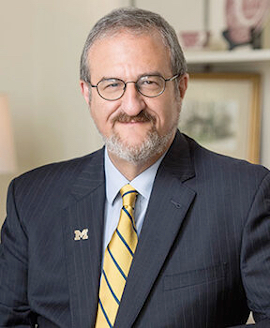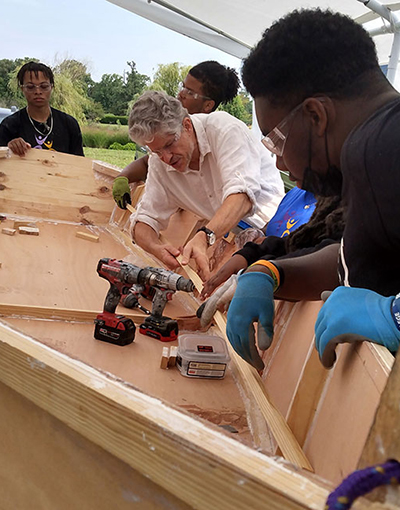President’s Message

The University of Michigan has always been a place known for our work to address major challenges.
Our students face the challenges of a rigorous academic experience and carving out their niche in an ever-changing world. Our faculty face the challenges of educating the next generation of leaders and thinkers, as well as addressing some of our society’s most pressing problems through research, creativity and innovation. Our staff face the challenges of providing top levels of service that make U-M’s campuses and patient care exemplary. And as leaders, we’re challenged each day to build on the successes of our predecessors and ensure that our university will always live up to its critical public mission.
The challenges of the past year have been unlike any others as the global COVID-19 pandemic upended so much of how we all live, work and learn and tested our ability to adapt, move forward and achieve success. The university has risen to these challenges at every turn.
I’m pleased to report that nearly 21 months after the first cases of COVID-19 occurred in our region, the University of Michigan continues to thrive, with a renewed commitment to outstanding education and betterment of the public good.
Across our three campuses, more than 65,000 students are pursuing their academic goals and earning their degrees in a wide breadth of disciplines. Our health care professionals at Michigan Medicine, who facilitated more than 2.6 million clinic visits with patients last year, remain on the front lines of combatting COVID-19 in our region. And University of Michigan researchers logged $1.58 billion in research volume during the past fiscal year, leading to advancements in areas ranging from firearm injury prevention to clean water that benefit our state, our nation and the world.
The university’s ability to deliver on its public mission is inextricably linked to our financial strength, and the Chief Financial Officer’s Report describes U-M’s sound financial position in detail.
PREVENTING AND ALLEVIATING POVERTY

One example of an important University of Michigan effort that has made incredible progress in recent years is the Poverty Solutions Initiative.
Recent Census Bureau research has shown a 30 percent decline in food insufficiency for adults with children and a 43 percent decline in food insufficiency for low-income households. These hopeful declines in hardship are the result of the payments that went out this year under the expanded Child Tax Credit – an expansion The New York Times and Time Magazine report was motivated in part by the work of U-M Professor Luke Shaefer and Poverty Solutions.
Dr. Shaefer and his colleagues advocated for the expanded credit, providing analysis that demonstrated its benefits, and in July 2020, testified before Congress. The CTC expansion was signed into law by President Biden on March 11, 2021, as part of the American Rescue Plan.
A policy brief by Poverty Solutions faculty members Natasha Pilkauskas and Patrick Cooney noted that the expanded CTC has already reduced child poverty by nearly 30 percent. That’s 3.5 million children lifted out of poverty.
Thanks to many faculty members, students, staff and an impressive array of partners, we are realizing this initiative’s vision — to partner with communities and policymakers to find new ways to prevent and alleviate poverty — and we’re seeing the benefits during a time when our work was so desperately needed.
UNLEASHING IMAGINATION AND CREATIVITY

When I announced the start-up phase of a comprehensive arts initiative at the university in late 2019, I never would have guessed what awaited us in the months soon after. The realities of living through a global pandemic over the past two years have shown us why the arts are so important for a healthy, functioning society.
The U-M Arts Initiative was built upon the fundamental notion that the arts are as essential to a university as they are to life itself. They make us excellent, complete and comprehensive; teach us new ways to visualize and understand; and take us far beyond their instrumental value to a place where we can address some of humanity’s most profound questions through creativity and imagination.
During the start-up phase, the Arts Initiative has helped us find ways to heal from the pandemic. In partnership with the University Musical Society, renowned cellist Yo-Yo Ma spent a six-month residency alongside our students and local artists to develop a “Travel Guide for Talking Hearts.” One aspect of this guide called on participants to reflect through writing, drawing and conversation on questions such as, “What must we remember about this past year, and what must we forget?”
There are several more impactful projects already underway for the year ahead. As we look to what the future holds for our campus, the Arts Initiative will be a vital force for advancing new ways to solve problems, provoke difficult conversations, heal, connect, learn and grow – while providing inspiration to the many communities we serve.
FURTHERING OUR PUBLIC MISSION
Efforts like Poverty Solutions and the Arts Initiative would not be possible without a firm financial foundation that allows us to be bold in advancing our public mission.
In support of U-M’s continued excellence, I’m very excited to have recently welcomed Geoffrey Chatas, our new executive vice president and chief financial officer, to the university.
Chatas, who joined us at the beginning of October 2021 after serving as senior vice president and chief operating officer for Georgetown University, brings with him an incredible depth of experience and proven skills that make him ideally suited for the responsibilities of the university’s chief advisor on financial matters.
Additionally, the generous contributions of the U-M family continue to be a critical component of our financial strength. U-M donors provided $432 million in pledge payments and cash gifts over the last year, as detailed in the Report of the Vice President for Development. This outstanding generosity allowed us to better navigate the challenges of the pandemic while continuing to serve our communities and the world at large.
It is what the University of Michigan has done for more than two centuries through education, research, patient care and service. We look forward to furthering that mission through innovation, creativity and an unwavering commitment to excellence in the years ahead.
Sincerely,

Mark S. Schlissel
President
